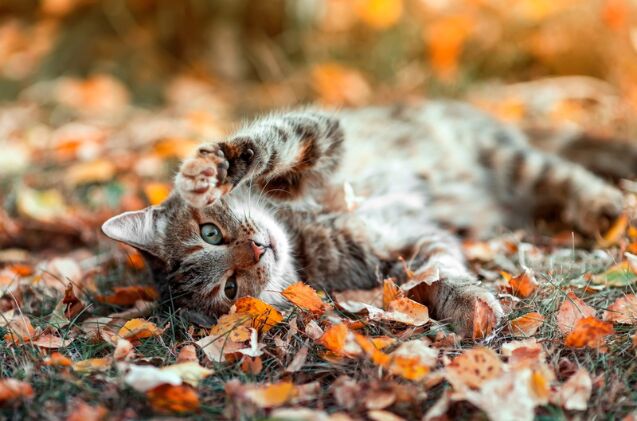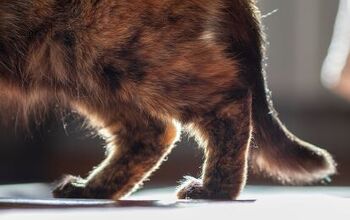Do Cats Slow Down in Autumn?

As the sunshine starts to fade, replaced by the cool autumn winds, cat owners may notice an interesting change in their furry friend’s behavior. Cats are often known for their boundless energy and curiosity. However, as we move into the fall months, many cat owners will notice their pets are slowing down into a new, more laid-back routine.
In this article, we dig into the reasons why cats slow down in autumn, including answering the question: “Do cats experience seasonal depression?” We will also share some tips and tricks to cheer up your sad cat and help them enjoy the colder months ahead.
Do Cat Behaviors Change with the Seasons?
The short answer is yes. Many cat owners report that their feline friends act differently during the fall and winter months. Some common changes include a difference in your cat’s sleep patterns, appetite, and overall mood.
For outdoor cats or indoor cats that are leash and harness-trained, the arrival of a new season means new experiences, including new smells, sights, and sounds. Anytime cats are faced with something new or different, the possibility exists that their reaction to their environment may change as well. But this isn’t the only impact on your cat…
From season to season, we see two key changes affecting a cat’s behavior – the temperature and the amount of daylight. A drop in temperature triggers a natural survival response in which your cat will slow down to conserve energy, allowing its ancestors to stay warm on the bitter cold nights in the wild. Meanwhile, a change in daylight has been shown to impact hormone levels.
Each of these factors will impact every cat differently. If you have multiple cats in your home, you may notice one slowing down considerably while the other doesn’t alter their behavior much at all – and that’s okay! Just like people, no two cats are the same.
Can Cats Get Seasonal Depression?
There currently is no research confirming that cats suffer from seasonal depression. However, many experts suspect they may suffer from a similar struggle to their human counterparts because of the shorter days and loss of daylight. This low mood and depression may also occur due to (or be escalated by) the lack of exercise that cats experience during the colder months.
Are Cats Less Active in Fall?
Have you noticed your cat lazing around or sleeping more during the autumn months? If so, you’re not alone! As we previously discussed, the temperature change often triggers a survival response to conserve energy. Your cat may prefer to spend their time curled up in their favorite cat bed, napping through the day, or cuddling in your lap, soaking up your body heat.
Keep your eyes open for any other signs of concern. But if you do not see any other reason to worry, the cozy fall attitude is normal. Enjoy the extra cuddle time with your best friend.
How Can I Tell if My Cat is Depressed?
As cat parents, we all want to provide the best life for our feline friends, both physically and mentally. This starts with learning to recognize when something is “off” or if there is something that we should address. Like us, our cats can suffer from mental health struggles like depression, which isn’t always easy to spot.
Here are a few signs your cat may be suffering from depression:
- Sleeping more than usual
- Loss of appetite
- Weight loss
- Becoming more vocal
- Failure to keep up with grooming needs
- Loss of energy
- Hiding or retreating from family members
- Out-of-character aggression or fearfulness
If you notice any of these signs, contact your veterinarian and discuss your concerns. They will likely ask questions about your cat’s home life and whether they have recently experienced any changes that may have triggered their mental health struggles. This can help to guide their treatment recommendations.
Mental health problems are not always treated with medications. In fact, many of the most effective treatment options are things that you can do at home.
How Do You Cheer Up a Sad Cat?
There is no one-size-fits-all solution to feline depression. You may find the answer in the following situations. Or you may find that combining several of these tips is the right approach for your cat. Luckily, many of these are simple and easy to incorporate into your daily routine.
Be Patient
It can be frustrating or upsetting to deal with some of these symptoms. For example, if your cat is crying out all night, it could impact your sleep. Try to remember that your cat isn’t doing these things to spite or upset you – they are struggling, too! Your cat needs your patience, understanding, and compassion at this time.
Rule Out Other Medical Concerns
Signs of illness are rarely exclusive to just one condition. A quick checkup with your veterinarian will give them the opportunity to rule out physical ailments that could explain the physical and behavioral changes. If an underlying medical condition is at play, your vet can recommend the best steps for treatment. In many cases, addressing the underlying problem may also fix your cat’s mental health, allowing them to return to their usual selves. However, in some cases, a little extra love and care may be needed to move past their condition.
Address Unnecessary Stress
Has something recently changed in your home that could be causing stress and anxiety for your cat? If so, this could be a contributing factor. Cats may exhibit depression after significant life changes, like the loss of a loved one, a new family member joining the household, or a big move. Unfortunately, these situations aren’t easy to fix because you can’t rewind time – you will need to help your cat adapt to their new “normal” and move forward. But significant changes aren’t the only potential causes of stress.
Take a moment to reassess your cat’s daily routine and anything that could be upsetting them. Do you have another cat that may be picking on them? Have you been doing work in the house that could be bothering your cat, like a recent renovation? Reducing or removing a stress trigger could be the solution that you are looking for.
Stick to Your Routine
Cats crave routine. It gives them a sense of security and stability, which could help your cat overcome stress or anxiety in their daily lives. Feed your cat at the same time each day. If your cat is leash-trained and enjoys going for walks or spending time in the yard, try to stick to doing these activities at the same time each day. Does your cat enjoy snuggling with you in bed before you go to sleep? If so, try to do that daily, making it part of your bedtime routine.
Encourage Your Cat to Eat
If your cat has stopped eating because of their depression, this could quickly lead to further complications. While encouraging your cat to eat isn’t going to solve the greater problem (the depression), it can help to prioritize their health and well-being as you work to find the right solution.
Here are a few tricks that may help to entice your cat to eat:
- Warm their food, as it will intensify the scent
- Add strong-smelling (cat-friendly) foods like tuna
- Water down or blend food for easier swallowing
- Add salt-free broth or warm water to create a “gravy”
- Rehydrate kibble to make it easier to eat
- Feed your cat by hand
- Offer your cat’s favorite treat either alone or mixed into their food
- Try adding a food topper to their meal
- Offer smaller meals more frequently throughout the day
If your cat has significantly cut back on what they eat or refuses to eat for a day or more, contact your veterinarian. In severe situations where a cat has gone without eating for a long time, they may recommend syringe feeding or bringing them in for supportive care.
Always ensure that they have access to plenty of cool, fresh water. Monitor the amount of water your cat is consuming. In the event that they stop drinking, contact your vet immediately.
Offer Entertainment and Enrichment
Boredom is one of the most common causes of feline depression. Luckily, it’s also one of the easiest causes to address and overcome. The best solution for boredom is to offer enough opportunities for entertainment and enrichment in your home, preventing boredom before it has a chance to set in. To begin, take a walk around your house and consider what opportunities currently exist in your home. Do they have scratch posts they can climb on? Are there fun and interactive toys or puzzle toys to play with?
One way to increase your cat’s playtime and reduce boredom is to plan to play with your cat using a wand-style cat toy. Not only could this help with your cat’s depression, but it is also an excellent opportunity to strengthen your bond.
For cat parents with a busy schedule, you may need to consider toys that allow for solo play. There are many interactive toys on the market designed to attract your cat’s attention and encourage them to play. Our cats love the PetSafe Peek-A-Bird Electronic Toy. The toy has a feather teaser that moves back and forth on each side of the toy. A motion sensor on the front activates the feather each time your cat comes near.
Try turning mealtime into an enrichment opportunity by feeding your cat using a food puzzle toy like the Nina Ottosson by Catstages Buggin’ Out Puzzle & Play. If you feed your cat canned food or soft treats, a lick mat like the LickiMat Casper is another option our cats love.
Consider Another Cat
If the depressed cat is your only cat, and you are prepared to take on the responsibility of another animal, you may want to bring a second cat into the home for companionship. Of course, this will depend mainly on your cat and their comfort level with other pets. For some, the camaraderie and entertainment of having a playmate can help to reduce or eliminate their mental health challenges. However, for others, bringing another cat into “their space” can cause stress and anxiety, escalating the problem. You know your cat best.
Take a moment to evaluate your cat’s age and activity level – this should be factored into the decision process. For example, adding a kitten to a home with a senior cat can go two ways. For some, the kitten will encourage the older cat to be active and play. But this isn’t true for all. Some older cats will become annoyed and frustrated with the energy of a young kitten.
In addition to your cat’s feelings about a new feline family member, you must also consider the responsibility and commitment that comes with a second pet. You want to ensure this is the right choice for everyone in the household.
Speak with a Board-Certified Animal Behaviorist
Some situations are best handled by a professional. If your veterinarian has ruled out medical causes and all efforts to address your cat’s mental health have failed, you may need to consult a board-certified animal behaviorist. They will observe and assess your cat’s behavioral responses to better understand the reason for your cat’s struggles and how to address them.
Final Thoughts: Do Cats Slow Down in Autumn?
Is your cat slowing down as you enter the autumn months? If so, you’re not alone. There are several reasons your cat may be exhibiting a change in behavior, many of which are normal and not concerning. The shift in temperature and loss of daily sunlight can trigger a natural survival response, resulting in your cat napping more and conserving energy.
While no definitive studies have proven that cats can experience seasonal depression, many experts agree that many cats exhibit behaviors that would fall into this category. If you notice signs of depression in your cat, contact your veterinarian to rule out medical causes.
Treatment for seasonal depression will vary from cat to cat. While some will thrive off minor lifestyle changes, like creating a steady routine and eliminating stress triggers, others will require more significant changes, including introducing new mental enrichment opportunities or consulting a board-certified animal behaviorist.
The good news is that feline depression is treatable! It will take patience and compassion, but you can help your cat navigate this challenge and return to “normal” once again.

Britt Kascjak is a proud pet mom, sharing her heart (and her home) with her “pack” which includes her husband John, their 2 dogs – Indiana and Lucifer – and their 2 cats – Pippen and Jinx. She has been active in the animal rescue community for over 15 years, volunteering, fostering and advocating for organizations across Canada and the US. In her free time, she enjoys traveling around the country camping, hiking, and canoeing with her pets.
More by Britt
























